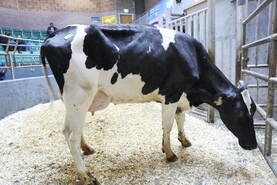Prices in marts across the country have moved up another step in the past week, with all types of stores and fed cattle seeing a boost.
Following the opening of marts to ringside buyers in the middle of last month, prices started to ease back slightly.
However, this was largely down to the reduction in grass growth at the same time, rather than the presence of buyers.
The last two weeks of mixed weather between rain and sunshine has led to grass bursting out of the ground on most farms.
This super grass growth is after giving an added push to mart prices, with farmers looking to stock up to meet the extra supply.
Seeing the biggest increase on the week was top-end heifers between 400kg and 500kg
This is particularly noticeable in the store trade, which tended to be the first to drop on price last month. Prices on the week rose by between 5c/kg and 12c/kg for light stores.
Seeing the biggest increase on the week was top-end heifers between 400kg and 500kg, which boasted an average of €2.61/kg, up 12c/kg on the week.
Lesser-quality lots in this weight category rose by 7c on the week to make their way past the €2/kg mark again.
It was a similar note for store heifers under 400kg, with better-quality lots rising by 11c to settle at €2.57/kg and lesser-end lots again making their way past €2/kg.
The average for all heifers sub-500kg rested at an impressive €2.30/kg.
Top price in store steers was paid for those better-quality lots from 400kg to 500kg, which saw average prices rest at €2.54/kg
Steer prices are back nicely from these, but still saw similar increases as the heifers on the week. Poorer-quality steers are back in the region of 20c/kg on the heifers, while the better-quality lots reduce to closer a 10c/kg difference.
Top price in store steers was paid for those better-quality lots from 400kg to 500kg, which saw average prices rest at €2.54/kg.
Buyers remain eager for short-keep lots, with Northern agents still very active for this type too.
Seeing the biggest changes in this type of animal was the lesser-type animal, with heifers rising by 9c/kg to rest at €2.09/kg.
The better type of animal in this weight category saw the least change, up 4c/kg for heifers and no change for bullocks.
The month of June generally tends to be a tight month for fed cattle to get slaughtered, with the majority of cattle killed straight from the shed done at this stage
Fed cattle continue to be a phenomenal trade ringside. While the changes on the week may not seem as big as some of the other categories, it must be remembered prices for this type of stock never saw a real drop when grass supply was tight.
Factory agents remain very eager ringside for cattle for direct slaughter, despite talks of them no longer buying at marts.
Good-quality bullocks and heifers are surpassing an average of €2.50/kg ringside
The month of June generally tends to be a tight month for fed cattle to get slaughtered, with the majority of cattle killed straight from the shed done at this stage, while cattle suitable for summer grazing won’t be in fit condition until later in the year.
Good-quality bullocks and heifers are surpassing an average of €2.50/kg ringside.
If we take a 600kg animal killing out at 55%, it means to break even with the mart, the factory needs to be paying €4.55/kg.
Certainly, something to bear in mind for those with fit stock for sale.






 This is a subscriber-only article
This is a subscriber-only article










SHARING OPTIONS: